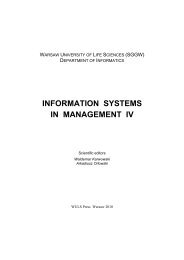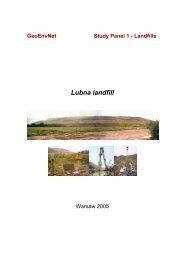122 J. WiśniewskaStatistical analyses, based on average values, deform the real picture of where theexistence of economic and social differences is obvious, to which degree it can be takeninto account and considered in different aspects of economic policy and to which degreeit constitutes a marginal phenomenon. Significant discrepancies appear among the subjectsof economy and the attempt at comparing them results in a number of problems anddifficult choices, being often virtually impossible. Strong comparability is based on existenceof a single comparative measure like “utility” by which all actions can be ranked[Spangenberg 2005].Although focussed on sustainability, this brings to a light, the fundamental discrepanciesbetween the participants of sustainable development and of some of their commonground. There are defined a weak and strong comparability and commensurability ofassessments in the above mentioned four dimensions: economic, environmental, socialand institutional. A common unit of measurement of sustainability is not existing yet.Thereof, a wide set of indicators has been approved and developed recognised as a weakcomparability and commensurability of some of the sustainable impacts.To summarize, principally the sustainability criteria comprise incomparable and incommensurableeconomic, environmental, social and institutional qualities. The overallsustainability of the economy comprise all four dimensions. A common unit of measurementof sustainability has not been developed yet. In the recent studies and literaturemostly economic measures of sustainability of social security systems, environmentalprotection, institutional potential and economic development have been considered.CONCEPTION OF SUSTAINABLE AGRICULTUREAlthough it represents nowadays only a small % of GDP in most of the countries allover the world, agriculture is very closely linked to the sustainable development. The sectoruses environmental inputs such as land and water, and generates many outputs of environmentalsignificance. As production intensity and output have increased, environmentalpolicy issues have risen in importance across the world. Policy challenges facing postindustrialeconomies include reducing environmental impacts and risks from agriculture,responding to international environmental agreements which often touch on aspects ofagriculture, and optimising agriculture’s overall contribution to welfare [OECD 2000].Progress in the farming sector is one of the conditions to be met in order to reach the definedaims of sustainable development. Due to its particular position connected with usingnatural resources on earth, it is the central point of the theory of sustainable development.Some definitions directly result from the principle saying that it is possible to derive fromearth only as much as it is able to offer [Florczak 2008].There is no generally accepted definition of sustainable agriculture. Conway and Barbier[1990] defined sustainable agriculture as the ability to maintain productivity, whetherof a field, farm or nation, in the face of stress or shock (such as increasing salinity, orerosion, or debt, or a new pest, or a rare drought or a sudden massive increase in inputprices). A case in point is the definition of the United Kingdom governmental Departmentof Environment Food and Rural Affairs (DEFRA) signifies several important attributes ofsustainable agriculture: availability to the consumers of adequate supplies of wholesome,Acta Sci. Pol.
Economic sustainability of agriculture – conceptions and indicators 123varied and reasonably priced food, produced within accordance with generally acceptedenvironmental and social standards, flexible and competitive industry which contributesto an economically viable rural society, effective protection of the environment and prudentuse of natural resources, conserved and enhanced landscape, wildlife, cultural andarcheological value of agricultural land and respecting of high level of animal welfare,contribute to the long-term sustainability of rural communities [DEFRA 2006].The OECD definition of sustainable agriculture says that this is agricultural productionthat is economically viable and does not degrade the environment over the long run[OECD 2000a]. As detailed in a report by the Committee for Agriculture of the Food andAgriculture Organization of the United Nations (FAO) changes in perception in relationto the interpretation of Sustainable Agriculture and Rural Development (SARD) areemerging: “The first is that the concept must extend to social, institutional and economicsustainability and not exclusively environmental sustainability – the conservation andrational utilization of natural resources. Those now working on SARD understand thatsustainability means that management practices must be profitable and socially and culturallysuitable, and must satisfy local requirements such as property rights over naturalresources. The second is a new focus on development as a process which must allow forcalculated trade-offs between reductions in the stock of natural capital (forests, unexploitedfreshwater, etc.) and the generation of resources for investment in human and socialcapital (healthier and better educated people, technical knowledge and infrastructure).These shifts in perception increase the challenge of implementing SARD, but also openup opportunities for doing so” [The Place… 2001].In the United States the term ‘sustainable agriculture’ was defined in 1977 year asan integrated system of plant and animal production practices having a site-specific applicationthat will, over the long-term satisfy human food and fiber needs, enhance environmentalquality and the natural resource base upon which the agriculture economydepends, make the most efficient use of nonrenewable resources and on-farm resourcesand integrate, where appropriate, natural biological cycles and controls, sustain the economicviability of farm operations and enhance the quality of life for farmers and societyas a whole [National… 1977]. The United States Network of Sustainable AgricultureResearch and Education (SARE) defines thus sustainable agriculture refers to an agriculturalproduction and distribution system that achieves the integration of natural biologicalcycles and controls, protects and renews soil fertility and the natural resource base,optimizes the management and use of on-farm resources, reduces the use of non-renewableresources and purchased production inputs, provides an adequate and dependablefarm income, promotes opportunity in family farming and farm communities, minimizesadverse impacts on health, safety, wildlife, water quality and the environment [Food…1990].In the European Union (EU) interventionism in the farming sector has become astandard rather than an exception, which it is for non-farming sectors of economy. Atthe beginning of the 21st century, a number of questions have arisen, e.g. whether stateinterventionism was one of the causes of attenuating eco-development by resulting inan intensification of the farming economy in the former era. Will it presently enable tointroduce social and political changes and will it determine farmers to implement thecurrent targets of economic policy, not straining the budget? So far, the main aim of theOeconomia 10 (1) 2011
- Page 6 and 7:
6 A. Gawrońska, S. Paszkowskicultu
- Page 8 and 9:
8 A. Gawrońska, S. Paszkowskinumbe
- Page 10 and 11:
10 A. Gawrońska, S. PaszkowskiTabl
- Page 12:
12 A. Gawrońska, S. PaszkowskiTabl
- Page 15 and 16:
The distribution of social security
- Page 17 and 18:
%180,0160,0140,0120,0100,080,060,04
- Page 19:
The distribution of social security
- Page 22 and 23:
22 R. Hryniewski, W. Mądry, D. Goz
- Page 24 and 25:
24 R. Hryniewski, W. Mądry, D. Goz
- Page 26 and 27:
26 R. Hryniewski, W. Mądry, D. Goz
- Page 28 and 29:
28 R. Hryniewski, W. Mądry, D. Goz
- Page 30 and 31:
30 R. Hryniewski, W. Mądry, D. Goz
- Page 32 and 33:
32 R. Hryniewski, W. Mądry, D. Goz
- Page 35 and 36:
Oeconomia 10 (1) 2011, 35-43EDUCATI
- Page 37 and 38:
Education as an element of competit
- Page 39 and 40:
Education as an element of competit
- Page 41 and 42:
Education as an element of competit
- Page 43:
Education as an element of competit
- Page 46 and 47:
46 E. Majewski, P. Sulewski, M. Rag
- Page 48 and 49:
48 E. Majewski, P. Sulewski, M. Rag
- Page 50 and 51:
50 E. Majewski, P. Sulewski, M. Rag
- Page 52 and 53:
52 E. Majewski, P. Sulewski, M. Rag
- Page 54 and 55:
54 E. Majewski, P. Sulewski, M. Rag
- Page 56 and 57:
56 E. Majewski, P. Sulewski, M. Rag
- Page 58 and 59:
58 L. Mazal, K.J. RowlesIn the West
- Page 60 and 61:
60 L. Mazal, K.J. RowlesThe most im
- Page 62 and 63:
62 L. Mazal, K.J. RowlesGDPt= GDP0+
- Page 64 and 65:
64 L. Mazal, K.J. RowlesTHE TIME SE
- Page 66 and 67:
66 L. Mazal, K.J. RowlesTable 4. Ac
- Page 68 and 69:
68 L. Mazal, K.J. RowlesNelson Ch.R
- Page 70 and 71:
70 A. Ptak-Chmielewskastatistics, w
- Page 72 and 73: 72 A. Ptak-Chmielewska3025birth rat
- Page 74 and 75: 74 A. Ptak-ChmielewskaSECTOR OF ACT
- Page 76 and 77: 76 A. Ptak-Chmielewskabirth rate fo
- Page 78 and 79: 78 A. Ptak-Chmielewskawere trade fi
- Page 80 and 81: 80 A. Ptak-ChmielewskaREFERENCESBal
- Page 83 and 84: Oeconomia 10 (1) 2011, 83-95THE EFF
- Page 85 and 86: The effi ciency of selected real es
- Page 87 and 88: The effi ciency of selected real es
- Page 89 and 90: Table 1. Efficiency of real estate
- Page 91 and 92: The effi ciency of selected real es
- Page 93 and 94: The effi ciency of selected real es
- Page 95: The effi ciency of selected real es
- Page 98 and 99: 98 J. Sosnowski, G.A. CiepielaJalin
- Page 100 and 101: 100 J. Sosnowski, G.A. Ciepiela2007
- Page 102 and 103: 102 J. Sosnowski, G.A. CiepielaTabl
- Page 104 and 105: 104 J. Sosnowski, G.A. CiepielaTabl
- Page 106 and 107: 106 J. Sosnowski, G.A. Ciepiela1400
- Page 108 and 109: 108 J. Sosnowski, G.A. CiepielaOsek
- Page 110 and 111: 110 E. SzymańskaProducts by Activi
- Page 112 and 113: 112 E. Szymańskatroduced TFI which
- Page 114 and 115: 114 E. Szymańskabers of companies
- Page 116 and 117: 116 E. SzymańskaTable 3. Tourism v
- Page 118 and 119: 118 E. SzymańskaREFERENCESCoccossi
- Page 120 and 121: 120 J. WiśniewskaEvery society can
- Page 124 and 125: 124 J. WiśniewskaCommon Agricultur
- Page 126 and 127: 126 J. WiśniewskaTable 3. An attem
- Page 128 and 129: 128 J. Wiśniewskathe application o
- Page 130 and 131: 130 J. Wiśniewskainstitutional cos
- Page 132 and 133: 132 J. Wiśniewskaemployed in agric
- Page 134 and 135: 134 J. WiśniewskaLong term viabili
- Page 136 and 137: 136 J. Wiśniewska--The level of re
- Page 139 and 140: Oeconomia 10 (1) 2011, 139-148INNOV
- Page 141 and 142: Innovativeness of food production e
- Page 143 and 144: Innovativeness of food production e
- Page 145 and 146: Innovativeness of food production e
- Page 147 and 148: Innovativeness of food production e
- Page 149 and 150: Oeconomia 10 (1) 2011, 149-158LOCAL
- Page 151 and 152: Local governance activities in supp
- Page 153 and 154: Local governance activities in supp
- Page 155 and 156: Local governance activities in supp
- Page 157 and 158: Local governance activities in supp
- Page 159 and 160: Oeconomia 10 (1) 2011, 159-169CHANG
- Page 161 and 162: Changes in rural women’s movement
- Page 163 and 164: Changes in rural women’s movement
- Page 165 and 166: Changes in rural women’s movement
- Page 167 and 168: Changes in rural women’s movement
- Page 169: Changes in rural women’s movement
- Page 172:
Ewa SzymańskaTourism function of M
















